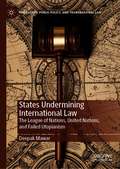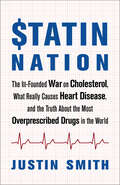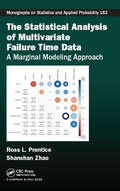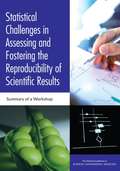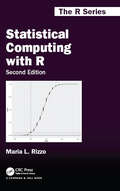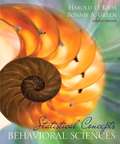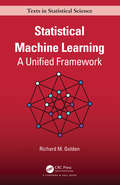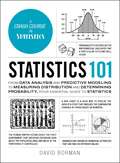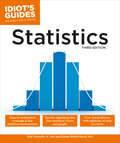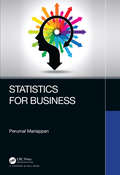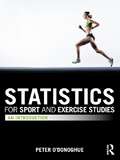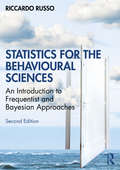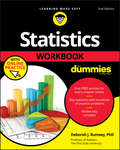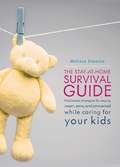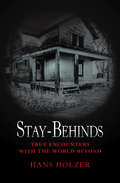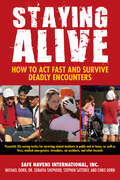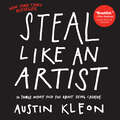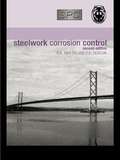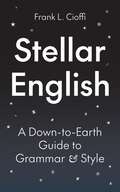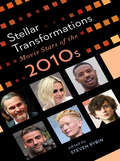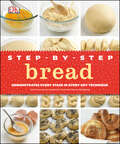- Table View
- List View
States Undermining International Law: The League of Nations, United Nations, and Failed Utopianism (Philosophy, Public Policy, and Transnational Law)
by Deepak MawarThis book analyses the history of international law to reveal the significant role utopianism has played in developing the international legal system. In fact, when pinpointing the legal system’s most accelerated phases of development, it becomes increasingly apparent how integral utopianism has been in dealing with the international community’s most troubled periods such as the World Wars. However, States have on numerous occasions undermined utopianism, leading to situations where individuals and communities have been vulnerable to modes of oppression such as war or repressive regimes. Thus, by examining the League of Nations and United Nations, this book seeks to show why utopianism continues to be a vital ingredient when the international community is seeking to ensure its loftiest and most ambitious goals such as maintaining international peace and security, and why for the sake of such utopian aspirations, the primary position States enjoy in international law requires reassessment.
Statin Nation: The Ill-Founded War on Cholesterol, What Really Causes Heart Disease, and the Truth About the Most Overprescribed Drugs in the World
by null Justin SmithA new understanding of heart disease and an innovative path to a viable alternative model to address the real causes of heart disease.Heart disease is the leading cause of death worldwide, and for decades conventional health authorities have pushed that the culprits are fat and cholesterol clogging up coronary arteries. Consequently, lowering cholesterol has become a hugely lucrative business, and cholesterol-lowering Statin drugs are now the most prescribed medication in the world, with clinical data showing one billion people eligible for prescription. However, these cholesterol guidelines have been heavily criticized, and increasingly, doctors and researchers have been questioning the role cholesterol plays in heart disease. We now know that people with heart disease often do not, in fact, have high cholesterol, and even the strongest supporters of the cholesterol hypothesis now admit that no ideal level of cholesterol can be identified.Large-scale studies have proven that statins are not generating the benefits that were predicted, and new research shows that high cholesterol may actually prevent heart disease. Worse still, millions of people in the United States and worldwide are taking statins preventatively, at great cost to their health. A complete reevaluation of the real causes of heart disease is long overdue, not to mention an inquiry into why the pharmaceutical industry continues to overprescribe statins (and market them aggressively to consumers) despite this evidence.Statin Nation offers a new understanding of heart disease, and Justin Smith forges an innovative path away from the outdated cholesterol myth with a viable alternative model to address the real causes of heart disease. Statin Nation provides detailed examinations of nutritional alternatives that are up to six times more effective than statins, and other interventions that have been shown to be up to eleven times more effective than statins. But all of these methods are currently ignored by health authorities. Smith provides a heart disease prevention plan that anyone can use, providing hope for the future of heart-disease treatment with a purpose.&“A complete and authoritative explanation of the causes of heart disease. . . This book fills an important need for a comprehensive explanation of the pharmaceutical industry&’s efforts to profit from statin drugs, of the trivial effect on prevention of heart disease by these drugs, and of their serious toxic side effects. More importantly, the book describes the true causes of heart disease and emphasizes optimal nutrition as the correct approach to prevention.&”—Kilmer McCully, MD, author of The Heart Revolution
The Statistical Analysis of Multivariate Failure Time Data: A Marginal Modeling Approach (Chapman & Hall/CRC Monographs on Statistics and Applied Probability #1)
by Shanshan Zhao Ross PrenticeThe Statistical Analysis of Multivariate Failure Time Data: A Marginal Modeling Approach provides an innovative look at methods for the analysis of correlated failure times. The focus is on the use of marginal single and marginal double failure hazard rate estimators for the extraction of regression information. For example, in a context of randomized trial or cohort studies, the results go beyond that obtained by analyzing each failure time outcome in a univariate fashion. The book is addressed to researchers, practitioners, and graduate students, and can be used as a reference or as a graduate course text. Much of the literature on the analysis of censored correlated failure time data uses frailty or copula models to allow for residual dependencies among failure times, given covariates. In contrast, this book provides a detailed account of recently developed methods for the simultaneous estimation of marginal single and dual outcome hazard rate regression parameters, with emphasis on multiplicative (Cox) models. Illustrations are provided of the utility of these methods using Women’s Health Initiative randomized controlled trial data of menopausal hormones and of a low-fat dietary pattern intervention. As byproducts, these methods provide flexible semiparametric estimators of pairwise bivariate survivor functions at specified covariate histories, as well as semiparametric estimators of cross ratio and concordance functions given covariates. The presentation also describes how these innovative methods may extend to handle issues of dependent censorship, missing and mismeasured covariates, and joint modeling of failure times and covariates, setting the stage for additional theoretical and applied developments. This book extends and continues the style of the classic Statistical Analysis of Failure Time Data by Kalbfleisch and Prentice. Ross L. Prentice is Professor of Biostatistics at the Fred Hutchinson Cancer Research Center and University of Washington in Seattle, Washington. He is the recipient of COPSS Presidents and Fisher awards, the AACR Epidemiology/Prevention and Team Science awards, and is a member of the National Academy of Medicine. Shanshan Zhao is a Principal Investigator at the National Institute of Environmental Health Sciences in Research Triangle Park, North Carolina.
Statistical Challenges in Assessing and Fostering the Reproducibility of Scientific Results: Summary of a Workshop
by National Academies of Sciences Engineering MedicineQuestions about the reproducibility of scientific research have been raised in numerous settings and have gained visibility through several high-profile journal and popular press articles. Quantitative issues contributing to reproducibility challenges have been considered (including improper data measurement and analysis, inadequate statistical expertise, and incomplete data, among others), but there is no clear consensus on how best to approach or to minimize these problems. A lack of reproducibility of scientific results has created some distrust in scientific findings among the general public, scientists, funding agencies, and industries. While studies fail for a variety of reasons, many factors contribute to the lack of perfect reproducibility, including insufficient training in experimental design, misaligned incentives for publication and the implications for university tenure, intentional manipulation, poor data management and analysis, and inadequate instances of statistical inference. The workshop summarized in this report was designed not to address the social and experimental challenges but instead to focus on the latter issues of improper data management and analysis, inadequate statistical expertise, incomplete data, and difficulties applying sound statistic inference to the available data. Many efforts have emerged over recent years to draw attention to and improve reproducibility of scientific work. This report uniquely focuses on the statistical perspective of three issues: the extent of reproducibility, the causes of reproducibility failures, and the potential remedies for these failures.
Statistical Computing with R, Second Edition (Chapman & Hall/CRC The R Series)
by Maria L. RizzoComputational statistics and statistical computing are two areas that employ computational, graphical, and numerical approaches to solve statistical problems, making the versatile R language an ideal computing environment for these fields. This second edition continues to encompass the traditional core material of computational statistics, with an
Statistical Concepts For The Behavioral Sciences
by Harold O. Kiess Bonnie A. GreenThis text emphasizes contemporary research problems to better illustrate the relevance of statistical analysis in scientific research. All statistical methods are introduced in the context of a realistic problem, many of which are from contemporary published research. Visit Bonnie and Hal's Statistical Sage Blog which includes helpful information on teaching and engaging students in your undergraduage statistics course! Click here:http://statisticalsage. wordpress. com/
Statistical Machine Learning: A Unified Framework (Chapman & Hall/CRC Texts in Statistical Science)
by Richard GoldenThe recent rapid growth in the variety and complexity of new machine learning architectures requires the development of improved methods for designing, analyzing, evaluating, and communicating machine learning technologies. Statistical Machine Learning: A Unified Framework provides students, engineers, and scientists with tools from mathematical statistics and nonlinear optimization theory to become experts in the field of machine learning. In particular, the material in this text directly supports the mathematical analysis and design of old, new, and not-yet-invented nonlinear high-dimensional machine learning algorithms. Features: Unified empirical risk minimization framework supports rigorous mathematical analyses of widely used supervised, unsupervised, and reinforcement machine learning algorithms Matrix calculus methods for supporting machine learning analysis and design applications Explicit conditions for ensuring convergence of adaptive, batch, minibatch, MCEM, and MCMC learning algorithms that minimize both unimodal and multimodal objective functions Explicit conditions for characterizing asymptotic properties of M-estimators and model selection criteria such as AIC and BIC in the presence of possible model misspecification This advanced text is suitable for graduate students or highly motivated undergraduate students in statistics, computer science, electrical engineering, and applied mathematics. The text is self-contained and only assumes knowledge of lower-division linear algebra and upper-division probability theory. Students, professional engineers, and multidisciplinary scientists possessing these minimal prerequisites will find this text challenging yet accessible. About the Author: Richard M. Golden (Ph.D., M.S.E.E., B.S.E.E.) is Professor of Cognitive Science and Participating Faculty Member in Electrical Engineering at the University of Texas at Dallas. Dr. Golden has published articles and given talks at scientific conferences on a wide range of topics in the fields of both statistics and machine learning over the past three decades. His long-term research interests include identifying conditions for the convergence of deterministic and stochastic machine learning algorithms and investigating estimation and inference in the presence of possibly misspecified probability models.
Statistical Modeling for Biomedical Researchers
by William D. DupontThis text will enable biomedical researchers to use a number of advanced statistical methods that have proven valuable in medical research. It is intended for people who have had an introductory course in biostatistics. A statistical software package (Stata) is used to avoid mathematics beyond the high school level. The emphasis is on understanding the assumptions underlying each method, using exploratory techniques to determine the most appropriate method, and presenting results in a way that will be readily understood by clinical colleagues. Numerous real examples from the medical literature are used to illustrate these techniques. Graphical methods are used extensively. Topics covered include linear regression, logistic regression, Poisson regression, survival analysis, fixed-effects analysis of variance, and repeated-measures analysis of variance. Each method is introduced in its simplest form and is then extended to cover situations in which multiple explanatory variables are collected on each study subject.
Statistics 101: From Data Analysis and Predictive Modeling to Measuring Distribution and Determining Probability, Your Essential Guide to Statistics (Adams 101)
by David BormanA comprehensive guide to statistics—with information on collecting, measuring, analyzing, and presenting statistical data—continuing the popular 101 series. Data is everywhere. In the age of the internet and social media, we’re responsible for consuming, evaluating, and analyzing data on a daily basis. From understanding the percentage probability that it will rain later today, to evaluating your risk of a health problem, or the fluctuations in the stock market, statistics impact our lives in a variety of ways, and are vital to a variety of careers and fields of practice. Unfortunately, most statistics text books just make us want to take a snooze, but with Statistics 101, you’ll learn the basics of statistics in a way that is both easy-to-understand and apply. From learning the theory of probability and different kinds of distribution concepts, to identifying data patterns and graphing and presenting precise findings, this essential guide can help turn statistical math from scary and complicated, to easy and fun. Whether you are a student looking to supplement your learning, a worker hoping to better understand how statistics works for your job, or a lifelong learner looking to improve your grasp of the world, Statistics 101 has you covered.
Statistics, 3E (Idiot's Guides)
by Robert A. Donnelly Fatma Abdel-RaoufStatistics is a class that is required in many college majors, and it&’s an increasingly popular Advanced Placement (AP) high school course. In addition to math and technical students, many business and liberal arts students are required to take it as a fundamental component of their majors. A knowledge of statistical interpretation is vital for many careers. Idiot&’s Guides®: Statistics explains the fundamental tenets in language anyone can understand. Content includes: - Calculating descriptive statistics. - Measures of central tendency: mean, median, and mode. - Probability. - Variance analysis. - Inferential statistics. - Hypothesis testing. - Organizing data into statistical charts and tables.
Statistics for Business
by Perumal MariappanStatistics for Business is meant as a textbook for students in business, computer science, bioengineering, environmental technology, and mathematics. In recent years, business statistics is used widely for decision making in business endeavours. It emphasizes statistical applications, statistical model building, and determining the manual solution methods. Special Features: This text is prepared based on "self-taught" method. For most of the methods, the required algorithm is clearly explained using flow-charting methodology. More than 200 solved problems provided. More than 175 end-of-chapter exercises with answers are provided. This allows teachers ample flexibility in adopting the textbook to their individual class plans. This textbook is meant to for beginners and advanced learners as a text in Statistics for Business or Applied Statistics for undergraduate and graduate students.
Statistics for Research: With a Guide to SPSS
by George ArgyrousIntroduction to the basic statistical concepts of data description, sampling estimation, inference and association/correlation. For students and professionals who do not have any existing knowledge in the field of statistics. A step-by-step approach takes the readers through the application of these concepts to concrete problems with explanations. For SPSS users, these examples are reworked with a guide to the commands required and an explanation of the output that is generated. Disks with the data necessary to generate the results and replicate the procedures described in the book are included in both Macintosh and PC formats. The author teaches in the School of Social Sciences and Policy at the UNSW. Also available in hardback.
Statistics for Sport and Exercise Studies: An Introduction
by Peter O'DonoghueStatistics for Sport and Exercise Studies guides the student through the full research process, from selecting the most appropriate statistical procedure, to analysing data, to the presentation of results, illustrating every key step in the process with clear examples, case-studies and data taken from real sport and exercise settings. Every chapter includes a range of features designed to help the student grasp the underlying concepts and relate each statistical procedure to their own research project, including definitions of key terms, practical exercises, worked examples and clear summaries. The book also offers an in-depth and practical guide to using SPSS in sport and exercise research, the most commonly used data analysis software in sport and exercise departments. In addition, a companion website includes more than 100 downloadable data sets and work sheets for use in or out of the classroom, full solutions to exercises contained in the book, plus over 1,300 PowerPoint slides for use by tutors and lecturers. Statistics for Sport and Exercise Studies is a complete, user-friendly introduction to the use of statistical tests, techniques and procedures in sport, exercise and related subjects. Visit the companion website at: www.routledge.com/cw/odonoghue
Statistics for the Behavioural Sciences: An Introduction to Frequentist and Bayesian Approaches
by Riccardo RussoThis accessible textbook is for those without a mathematical background (just some notions of basic algebra are sufficient) and provides a comprehensive introduction to all topics covered in introductory behavioural science statistics courses. It includes plenty of real examples to demonstrate approaches in depth based on real psychology experiments utilizing the statistical techniques described. New content in this thoroughly updated second edition includes an introduction to Bayesian statistics which complements the coverage of Classical/Frequentist statistics present in the first edition. It also offers practical details on how to perform analyses using JASP – a globally employed, freely downloadable statistical package. The updated eResources also feature a range of new material including additional exercises so readers can test themselves on what they have learned in the book. This timely and highly readable text will be invaluable to undergraduate students of psychology and research methods courses in related disciplines, as well as anyone with an interest in understanding and applying the basic concepts and inferential techniques associated with statistics in the behavioural sciences.
Statistics Workbook For Dummies with Online Practice
by Deborah J. RumseyPractice your way to a higher statistics score The adage that "practice makes perfect" is never truer than with math problems. Statistics Workbook For Dummies with Online Practice provides succinct content reviews for every topic, with plenty of examples and practice problems for each concept, in the book and online. Every lesson begins with a concept review, followed by a few example problems and plenty of practice problems. There's a step-by-step solution for every problem, with tips and tricks to help with comprehension and retention. New for this edition, free online practice quizzes for each chapter provide extra opportunities to test your knowledge and understanding. Get FREE access to chapter quizzes in an online test bank Work along with each chapter or use the test bank for final exam review Discover which statistical measures are most meaningful Scoring high in your Statistics class has never been easier!
The Stay-at-Home Survival Guide: Field-Tested Strategies for Staying Smart, Sane, and Connected When You're Raising Kids at Home
by Melissa StantonMelissa Stanton's The Stay-at-Home Survival Guide is an all-encompassing, truth-telling how-to book that addresses the many practical and psychological issues facing stay-at-home moms today.How do you create time for yourself? Is there really time to do it all (feed the kids, keep them busy, clean the house, balance the checkbook, and take a shower)? How do you deal with the absence of the "professional you"?An invaluable resource for mothers, The Stay-at-Home Survival Guide includes interviews with stay-at-home moms, discussions with experts (family therapists, educators, medical specialists, career counselors), checklists to help you make the most of your time and keep you balanced, and Melissa Stanton's own experiences leaving a career as an editor for People magazine to become a stay-at-home mom herself.
Stay-Behinds: True Encounters With The World Beyond (True Encounters with the World Beyond #9)
by Hans HolzerParanormal expert Hans Holzer investigates some of the strangest and most difficult cases of loved ones who are simply not ready to leave their earthly lives The &“stay-behind,&” a term coined by professor Hans Holzer, is a ghost who is not prepared to move to the &“other side,&” but prefers to remain among loved ones and its former home. In Stay-Behinds, Holzer reveals some of the most famous cases of these beings, including the haunting of Rose Hall Plantation in Jamaica and the strange case of Mrs. C.&’s late yet lively husband.
Stay Weird: Upbeat Quotes and Awesome Statements for People Who Are One of a Kind
by Summersdale PublishersWeird is wonderfulYou’re the doughnut with sprinkles in a world full of plain bagels – and that’s what makes you amazing! This little book, packed with quirky quotes and statements, is here to celebrate your one-of-a-kind brand of awesomeness!
Staying Alive: How to Act Fast and Survive Deadly Encounters
by Safe Havens International Inc Michael Dorn Sonayia Shepherd Steve Satterly Chris DornThe Boston Marathon; Sandy Hook Elementary School; the Aurora, Colorado movie theater; Columbine High School—sadly, most Americans are very familiar with these names and the tragic events that took place at each event or location. Mass shootings, home invasions, and other attacks on the general public are no longer the rare exception they were decades ago. No one wants to feel like a potential victim in their own neighborhood, but what can the average person do to stay safe?The authors of Staying Alive: How to Act Fast and Survive Deadly Encounters give us the answer to that question. Inside, they take the successful strategies that have been used to avert planned school shootings, bombings, and other deadly events and demonstrate how those techniques can be utilized by the average person. The powerful and potentially life-saving information in this book includes:An honest look at the myths and truths surrounding mass casualty eventsProven strategies for surviving violent incidents in malls, movie theaters, places of worship, and at homeSafety concepts that can be applied to fires, medical emergencies, tornadoes, car accidents, and other hazardsWith an in-depth look at mass casualty attacks across the centuries—including the earliest recorded incident in 1764 in Western Pennsylvania, a vivid review of case studies to help readers fine tune how they prepare for life and death situations, techniques for improving crisis response, and much more, Staying Alive offers everything the average person needs to know in order respond to, and recover from, a crisis. An ideal reference for school teachers, parents, security personnel, and all others responsible for the care and safety of others.
Staying Human During Residency Training
by Allan D. PeterkinThe ultimate survival guide for medical students, interns, residents and fellows, Staying Human during Residency Training provides time-tested advice and the latest information on every aspect of a resident's life - from choosing a residency program, to coping with stress, enhancing self-care, and protecting personal and professional relationships.Allan D. Peterkin, MD, provides hundreds of tips on how to cope with sleep deprivation, time pressures, and ethical and legal issues. This fifth edition features new, leading-edge information on enhancing personal resilience, planning one's career, pursuing leadership roles, and using new technologies to maximize learning. Presenting practical antidotes to cynicism, careerism, and burnout, Peterkin also offers guidance on fostering more empathic connection with patients and deepening relationships with colleagues, friends, and family.Acknowledged by thousands of doctors across North America as an invaluable resource, Staying Human during Residency Training has helped to shape notions of trainee well-being for medical educators worldwide. Informative, compassionate, and professional, this new edition will again show why it is required reading for medical students and new physicians pursuing postgraduate training.
Steal Like an Artist: 10 Things Nobody Told You About Being Creative (Austin Kleon)
by Austin KleonYou don’t need to be a genius, you just need to be yourself. That’s the message from Austin Kleon, a young writer and artist who knows that creativity is everywhere, creativity is for everyone. A manifesto for the digital age, Steal Like an Artist is a guide whose positive message, graphic look and illustrations, exercises, and examples will put readers directly in touch with their artistic side. When Mr. Kleon was asked to address college students in upstate New York, he shaped his speech around the ten things he wished someone had told him when he was starting out. The talk went viral, and its author dug deeper into his own ideas to create Steal Like an Artist, the book. The result is inspiring, hip, original, practical, and entertaining. And filled with new truths about creativity: Nothing is original, so embrace influence, collect ideas, and remix and re-imagine to discover your own path. Follow your interests wherever they take you. Stay smart, stay out of debt, and risk being boring—the creative you will need to make room to be wild and daring in your imagination.
Steelwork Corrosion Control
by D.A. Bayliss D.H. DeaconEngineers on major building projects continue to echo the sentiment that "painting amounts to 10% of the job, but provides 90% of the problems". This second edition of Steelwork Corrosion Control provides sound advice and authoritative guidance on the principles involved and methods of achieving sound steel protection. Taking into account the consi
Stellar English: A Down-to-Earth Guide to Grammar and Style (Skills for Scholars)
by Frank L. CioffiAn indispensable guide to essential principles of English grammar and usageStellar English lays out the fundamentals of effective writing, from word choice and punctuation to parts of speech and common errors. Frank Cioffi emphasizes how formal written English—though only a subdialect of the language—enables writers to reach a wide and heterogenous audience.Cioffi&’s many example sentences illustrating grammatical principles tilt in an otherworldly direction, making up a science fiction story involving alien invasion. Reading the book through will not only help you with your grammar but also reveal how the story ends!An invaluable brief handbook for native and nonnative speakers alike, Stellar English avoids the jargon and emphasis on outdated rules found in typical grammar guides and shows how good writing uses carefully constructed language that&’s at once appropriate to an audience and communicates—without distractions or confusion—just what the writer wants.
Stellar Transformations: Movie Stars of the 2010s (Star Decades: American Culture/American Cinema)
by Steven Rybin Brenda Austin-Smith Karen Hollinger Rick Warner David Greven Celestino Deleyto Jennifer O'Meara Danielle E. Williams Daniel Varndell Kyle Stevens Matt Connolly Cynthia BaronStellar Transformations: Movie Stars of the 2010s circles around questions of stardom, performance, and their cultural contexts in ways that remind us of the alluring magic of stars while also bringing to the fore the changing ways in which viewers engaged with them during the last decade. A salient idea that guides much of the collection is the one of transformation, expressed in these pages as the way in which post-millennial movie stars are in one way or another reshaping ideas of performance and star presence, either through the self-conscious revision of aspects of their own personas or in redirecting or progressing some earlier aspect of the culture. Including a diverse lineup of stars such as Oscar Isaac, Kristen Stewart, Tilda Swinton, and Tyler Perry, the chapters in Stellar Transformations paint the portrait of the meaning of star images during the complex decade of the 2010s, and in doing so will offer useful case studies for scholars and students engaged in the study of stardom, celebrity, and performance in cinema.
Step-by-Step Bread: Demonstrates Every Stage in Every Key Technique
by DKIf you want success in the kitchen, DK's new Step-by-Step Series will take you through every single stage of classic recipes with clear, illustrated, step-by-step instructions that guarantee you will be cooking with confidence. Presenting two hundred recipes in clear, step-by-step sequences — with every single stage demonstrated — Step-by-Step Bread covers Classic Breads and Artisan Breads, Flat Breads and Crisps, Quick Breads and Batters, as well as Sweet Breads. Step-by-Step Bread is packed with clear instructions, essential information on ingredients, special equipment and storage, and the world's favorite recipes.
